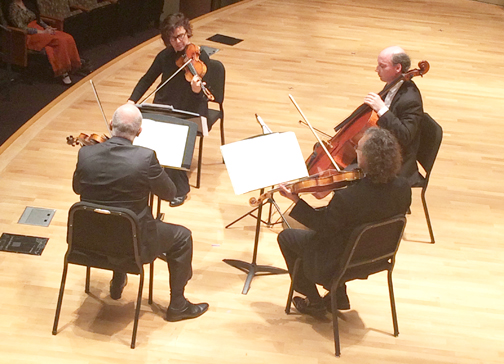This review was revised on April 27
It is human nature to wrest light and hope from tragedy, however painful and inexplicable. The enigmatic yet resigned line from Samuel Beckett’s “The Unnamable” –”You must go on, I can’t go on, I’ll go on” – tersely sums up the need to eke out even a meager flickering of joy amidst the ashes of suffering.
Though no work on the program at the concert commemorating the Armenian Genocide at the Hammer Museum, which was hosted by violinist Movses Pogossian, explicitly referenced the “Medz Yeghern” (“the great crime”), the memory of that suffering singed the wings of Armenian culture.
Whether in the handful of songs by Komitas, Arno Babajanian, or Romanos Melikian that baritone Garrett Schoonover and the VEM String Quartet dispatched with equal parts tenderness and quiet power, or the energetic “Rhapsodic Fantasy” for two cellos by Kristapor Najarian, given a searing performance by Antonio Lysy and Charles Tyler, a shadow of melancholy – sometimes receding, at other times growing darker – sweeps over much of Armenian music.
The two works that opened Dilijan Chamber Series’ final concert of their 2016-17 series on Sunday in some respects elaborated on what had been expressed at the Hammer concert.
The fascinating post-Shostakovichian expressiveness and declamatory power of Adam Khudoyan’s “Sonata for Solo Violin” from 1981 or Arno Babajanian’s nervy 1959 “Sonata for Violin and Piano,” with its flashes of Bartók and Prokofiev, both served up anger and rage, seemingly pacing restlessly. Especially striking was the Khudoyan score, which Pogossian brought to life with arresting precision and emotional intensity. He was abetted superbly by pianist Daniel Sedgwick in the Babajanian.
The gentle whimsy and sadness the Paul Coletti’s “Starlight Journey” and Brahms’ “String Quartet No. 2” further underlined the shadows that unified this program.
Transcendence was on display, both in performance and in score, on Saturday afternoon at the Huntington Gardens. Paolo Bordignon, under the auspices of Camerata Pacifica, performed J. S. Bach’s “Goldberg Variations” on a reproduction of a period harpsichord.
Whereas biography is sometimes inextricable from a composer’s work – think of Beethoven, Schumann, Mahler, or Shostakovich – Bach’s music stands apart from the life of the man. Joy and sorrow tint his scores without ever overwhelming the structure. It is music that encompasses emotion without ever becoming about it.
Bordignon’s performance was a quiet marvel of concentration that allowed the listener to relish the details of each variation without sacrificing architectural control. The result was of a kaleidoscopic mosaic, with each variation a dazzling piece that tells on its own as well as part of a whole. Everything was carefully sculpted and considered, yet sounded utterly spontaneous.
These three concerts – and their programs with music that spanned four centuries – were an edifying demonstration of the astonishing range of human creativity, of its capacity to transcend the particular and aim for the universal, of its ceaseless striving for the eternal.

